Kerala Plus Two Microeconomics Chapter Wise Previous Questions Chapter 2 Theory of Consumer Behaviour
Question 1.
The demand function of commodity X of three Households are given below: (MARCH-2008)
Household 1 – Dx = 50 – 5 Px
Household 2 – Dx = 50 – 6 Px
Household 3 – Dx = 50 – 3 Px
If the values of Px are (5,4, 3, 2,1)
a) Prepare the Household demand schedule.
b) Calculate the market demand schedule.
c) Draw the three Household demand curves on the same axis.
Answer:
a)


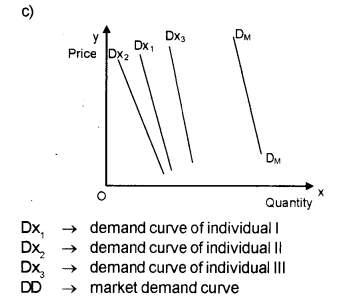
Question 2.
State whether the following statements are true or false. Justify your answer. (MARCH-2009)
a) Equilibrium price is the price at which the demand for the commodity is greater than its supply.
b) A rise in supply due to non-price factors is called
expansion in supply.
Answer:
a) False.
Equillibrium price is the price at which the demand for the commodity is equal to supply.
b) False.
Increase in supply.
Question 3.
Sree Ram buys 10kg of wheat at a price of ₹ 20 per kg. It is found that the price elasticity of demand is 2. At what price he will be ready to buy 15 kg. of wheat? Exhibit in a diagram. (MARCH-2009)
Answer:

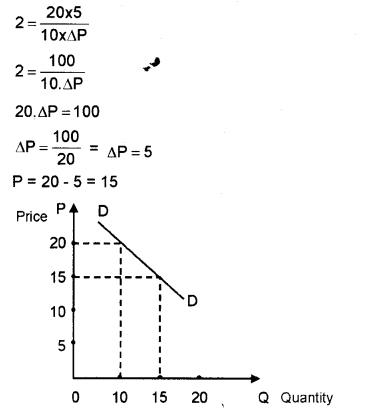
Question 4.
The Demand function of Commodity ‘y’ of two households are given below: (MARCH-2009)
Household I: DY = 80 – 20P Household II: DY= 100 – 20P If the value of Py are 1,2, 3,4, 5
a) Derive the demand schedule of two households.
b) Draw the two household demand curves on the
same axis.
Answer:
Demand Schedule of Household I
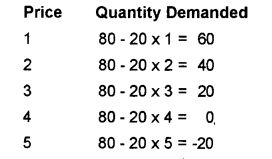
Demand Schedule of Household II
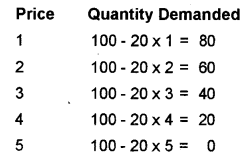
Question 5.
A seller supplies 100 Kg. of rice at price ₹25. It is found that price elasticity of supply is 2. At what price he will be ready to sell 150 Kg. of rice?
(MAY-2009)
Answer:
Price elasticity of supply is defined as the degree of responsiveness of change in supply due to change in price. That is,
–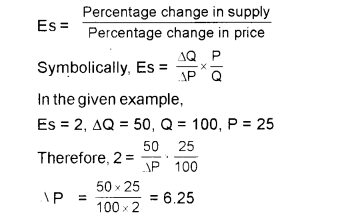
Therefore, new price = 25 + 6.25 = 31.25
Question 6.
The demand function of commodity x for three households are given below: (MAY-2009)
Dx= 300-30 Px (1)
Dx = 200 – 20 Px (2)
Dx= 200 – 10 Px (3)
If the value of Px are 5, 4, 3,2 and 1.
a) Prepare the individual demand schedule.
b) Prepare the market demand schedule.
c) Draw the market demand curve.
Answer:
a) There are Three individual demand schedules.
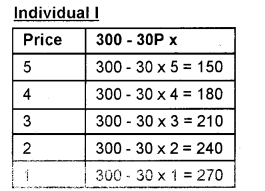
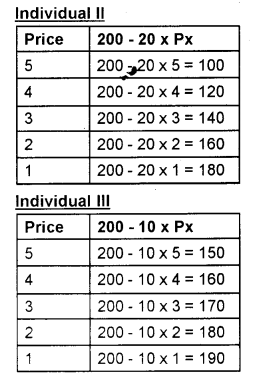
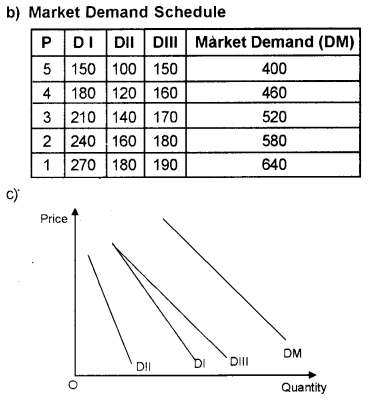
Question 7.
Calculate the elasticity of demand by using total expenditure method from the data given below: (MAY-2009)

Answer:

Change in price leading to changes in quantity demanded causes changes in total expenditure incurred on commodity. By looking at the variation in total expenditure, price elasticity can be calculated. Since total expenditure remaining the same when price changes, elasticity is equal to one (unitary elastic demand).
Question 8.
During Onam festival Govt, of Kerala offered 20% discount on the prices of Khadi items. As a result of this sales of Khadi items registered an increase of 30%. Find out price elasticity by applying appropriate method. (MAY-2009)
Answer:
Price elasticity of demand can be found out by using the formula
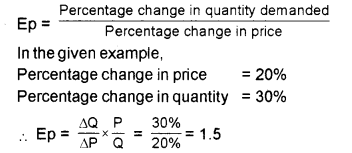
The method used here is percentage or proportional method.
Question 9.
What may happen to the supply of two wheelers if Tata introduces new car at low cost and supplies them in the market which is more or less equal to prices of two wheelers? (MAY-2009)
Answer:
When a new car is supplied in the market at a lower price, the demand for two wheelers will be reduced. This is because, more customers will switch over their demand of two wheelers and start demanding the new car.
Question 10.
The Govt, of Kerala decided to abolish lottery system from November2008 onwards. Do you agree with the policy of the Govt, of Kerala? Justify your answer. (MAY-2009)
Answer:
Yes/No
State any answer and substantiate the answer
Question 11.
A production possibility schedule for good x and y is given below: (MARCH-2010)
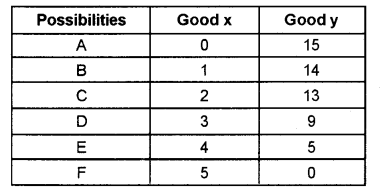
a) Define production possibility frontier.
b) Draw the PPC.
Answer:
a) A production possibility curve is a geometrical device representing all such combinations of two goods that can be produced with given technology and available resources,
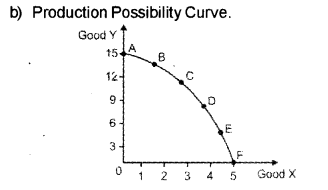
Question 12.
A consumer purchased 4 kg. of good A when his income was ₹500 per month. He reduces the consumption of good A to 2 kg. when his income alone increase to ₹1,000 per month. If so, (MARCH-2010)
a) State the nature of good A and justify.
b) Give one example for commodity like good A.
Answer:
a) Inferior goods or Giffen goods
b) Bajra, Ragi, Tapioca, etc.
Question 13.
An indifference curve possesses several properties. One of them is that, it is a downward sloping curve from left to right. Write any other two properties. (MARCH-2010)
Answer:
a) Indifference curve is convex to origin
b) Higher and higher indifference curve represents higher level of satisfaction.
c) Indifference curves never intersect each other.
Question 14.
Observe the diagram (MARCH-2010)
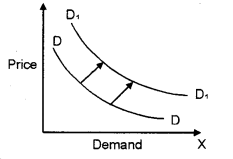
a) Comment on the given demand curve.
b) Give any two reasons for the positional change of demand curve from Dd to Dp.
Answer:
a) Shift in demand / increase in demand
b) Increase in income of the consumers. Change in taste and preference of the consumers.
Question 15.
“The direction of change in equilibrium price and quantity is same whenever there is a shift in demand curve.” (MAY-2010)
a) Identify the two types of shift in demand curve.
b) Draw the relevant diagrams.
Answer:
a) Increase in demand and decrease in demand.
b)

Question 16.
Ramu has an income of ₹20 and suppose he wants to consume two commodities X and Y, both the goods are priced at ₹4 per unit. (MAY-2010)
a) Find out all the budget sets available to Ramu.
b) Draw the budget-line.
c) What factors can change the budget set of Ramu?
Answer:
a) 4x + 4y = 20
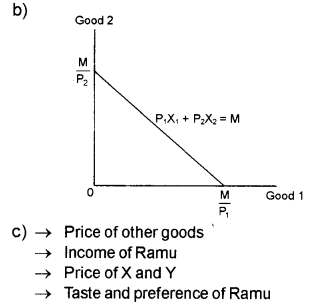
Question 17.
“Prices of related goods affect the household demand, and we can differentiate the related goods into two types.” (MAY-2010)
a) Which are the types of related goods that determine the demand?
b) Define them.
Answer:
) Substitutes
ii) Complementaries
b) Substitutes are those goods where one good can be used instead of other. Eg. Tea and Coffee. Complementary goods are those goods which are used together. Eg. Car and Petrol.
Question 18.
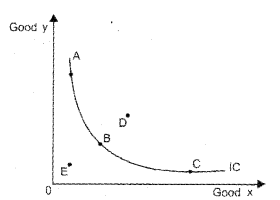
From the following indifference curve, mark (MARCH-2011)
a) monotonic preferences
b) inferior bundles
c) Preferred bundles
Answer:
a) D b) E c) D
Question 19.
Raghu, Yadav and Basheer are 3 customers who purchased mangoes from a market. Individual quantity demanded for mangoes are given in the schedule. (MARCH-2011)
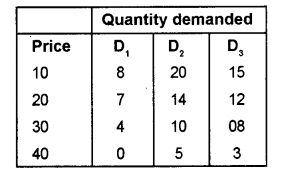
a) Construct market demand schedule
b) Draw market demand curve.
c) Based on the given schedule, identify the nature of good (Hint: Normal, Inferior, Giffen).
Answer:
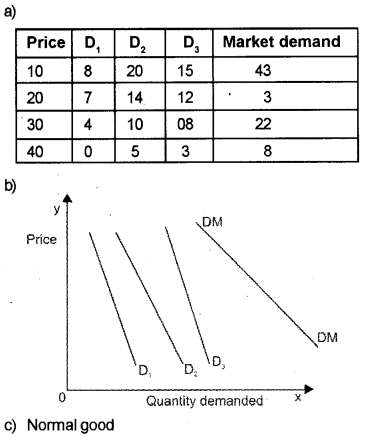
Question 20.
A consumer wants to consume two goods ‘x’ and ‘y’ with his income of ₹20. The prices of the two goods are ₹4 and ₹5 respectively.
a) Write down the equation of the budget line. (MARCH-2012)
b) Represent the budget line diagramatically.
c) How much of good x can the consumer consume if he spends his entire income on that good?
Answer:
a) 4x + 5y = 20

Question 21.
Consider the demand for a good. At a price ₹4 the demand for the good is 30 kg. Suppose price of the good increases to ₹5 and as a result the demand for the good falls to 20 kg. Calculate the price elasticity of demand. (MARCH-2012)
Answer:
Elasticity of demand

Question 22.
Consider the following figure: (MARCH-2012)
Why point E in the figure is considered as consumer’s optimum? Justify your answer.
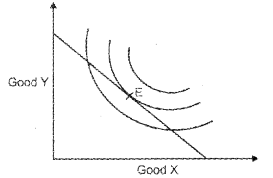
Answer:
Point E is considered as consumers’s optimum. The optimum bundle of the consumer is located at the point where the budget line is tangent to one of the indifference curves. It is drawn below
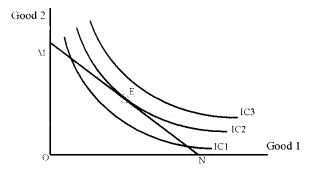
Condition I : Budget line should be tangent to the indifference Curve
Condition II: Slope of IC ((MRSxy)) should be equal to slope of budget line (Price Ratio)
Question 23.
In economics, it is generally assumed that consumer is rational. The consumer have well defined preference over a set of available bundle. He always tries to maximise his satisfaction or attain the optimum level. Diagrammatically illustrate the consumer’s optimum. (Hint: Consumer’s equilibrium). (MARCH-2013)
Answer:
Consumer’s Equilibrium
Consumer’s equilibrium shows a situation in which a consumer buys such a combination of goods from which he gets the maximum satisfaction with his given income and given prices of the goods.
The term consumer’s equilibrium refers to the amount of goods and services which the consumer may buy in the market given his income and given prices of goods in the market. The aim of the consumers is to get maximum satisfaction from his money income. Given the price line (budget line) and the indifference map, a consumer is said to be in equilibrium at a point where the price line is touching the highest attainable indifference curve from below. Thus the consumer’s equilibrium under the indifference curve theory must meet the following two conditions.
First order condition.
A given price line should be tangent to an indifference curve or marginal rate of substitution of good X for good Y (MRSxy) must be equal to the price ratio of the two goods.
(MRSxy) = (Px)/(Py) Second order condition.
The second condition is that indifference curve must be convex to the origin at the point of tangency. Assumptions
The following assumptions are made to determine the consumer’s equilibrium position.
(1) Rationality. The consumer is rational. He wants to obtain maximum satisfaction given his income and prices.
(2) Utility is ordinal. It is assumed that the consumer can rank his preferences according to the satisfaction of each combination of goods.
(3) Consistency of choice. It is also assumed that the consumer is consistent in the choice of goods.
(4) Perfect competition. There is perfect competition in the market from where the consumer is purchasing the goods.
The optimum bundle of the consumer is located at the point where the budget line is tangent to one of the indifference curves. It is drawn below.

Condition I: Budget line should be tangent to the in-difference Curve
Condition II: Slope of IC ((MRSxy)) should be equal to slope of budget line (Price Ratio)
Question 24.
Identify the relationship between good X and good Y. (MAY-2014)
i) Price of good X rises and demand for good Y rises, goods are
ii) Price of good X falls and demand for good Y rises, goods are
Answer:
i) Substitutes
ii) Complementary goods
Question 25.
Let Price of good X((Px)) = ₹3 price of good Y((Px)) = ₹5, income of the consumer (Y) = 130 and assume whole income is spend on good X and good Y. (MAY-2014)
a) Construct the budget equation and draw the budget line.
b) Suppose the prices of both goods, X and Y doubles, then what happens to the budget equation and the budget line?
c) Suppose income of the consumer (Y) doubles, then what happens to the budget equation and the budget line?
Answer:
a)

b) budget equation becomes 6X + 10 Y = 30 budget line will shift downward by half
c) budget equation becomes 3X+ 5 Y = 60 budget line will shift outward
Question 26.
Calculate the. price elasticity of demand from a movement from point A to B on the demand curve DD. (MAY-2014)
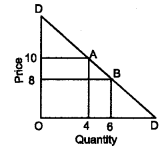
Answer:

Elasticity is 2.5. (Elastic demand)
Question 27.
If the demand curve is a rectangular hyperbola, elasticity is (MARCH-2015)
a) zero b) One
c) Less than one d) Infinity
Answer:
b) One
Question 28.
Mr. Abhi wants to consume two goods. The prices of two goods are ₹4 and ₹5 respectively. If Abhi’s income is ₹20, answer the following questions: (MARCH-2015)
a) Write down the equation of the budget line.
b) How much of good-1 that Abhi can consume if he spends his entire income on good-1?
c) How much of good-2 that Abhi can consume if he spends his entire income on good-2?
d) ‘ What is the slope of budget line?
e) How does the budget line change if the customer’s income increases from ₹20 to ₹40 but prices remain unchanged?
f) Show the change in budget line if the price is
good – 2 decreases by ₹1 but the price of good – 1 and consumers income remains unchanged.
Answer:
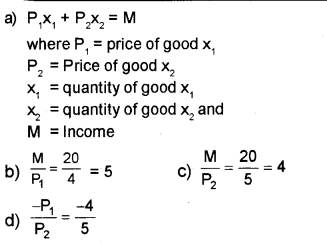
e) When income of the consumer increases without any changes in the price then the budget line shifts parallel upwards to the earlier budget line.
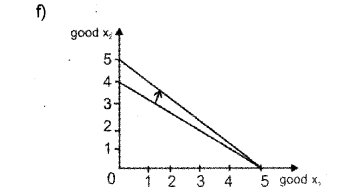
When only the price of good 2 decreases the budget line changes upwards in the good 2 axis, (vertical intercept)
Question 29.
“Consumer’s optimum bundle is located at the point of tangency between the budget indifference curve.” Explain with the help of a suitable diagram. Hint: Indifference Curve Analysis (MAY-2015)
Answer:
Consumer’s Equilibrium Consumer’s equilibrium shows a situation in which a consumer buys such a combination of goods from which he gets the maximum satisfaction with his given income and given prices of the goods.
The term consumer’s equilibrium refers to the amount of goods and services which the consumer may buy in the market given his income and given prices of goods in the market. The aim of the consumers is to get maximum satisfaction from his money income. Given the price line (budget line) and the indifference map, a consumer is said to be in equilibrium at a point where the price line is touching the highest attainable indifference curve from below. Thus the consumer’s equilibrium under the indifference curve theory must meet the following two conditions.
The following assumptions are made to determine the consumer’s equilibrium position.
1) Rationality. The consumer is rational. He wants to obtain maximum satisfaction given his income and prices.
2) Utility is ordinal. It is assumed that the consumer can rank his preferences according to the satisfaction of each combination of goods.
3) Consistency of choice. It is also assumed that the consumer is consistent in the choice of goods.
4) Perfect competition. There is perfect competition in the market from where the consumer is purchasing the goods.
The optimum bundle of the consumer is located at the point where the budget line is tangent to one of the indifference curves. It is drawn below.

Condition I: Budget line should be tangent to the indifference Curve
Condition II: Slope of IC (MRSxy) should be equal to slope of budget line (Price Ratio)
Question 30.
Suppose there was a decrease in the price of good ‘X’ and as a result, the demand for good ‘Y’ increases. What will be the type of goods? (MAY-2015)
Answer:
Complementary goods.
Question 31.
Consider the demand curve D = 10 – 3p. What is the elasticity of price \(\frac { 5 }{ 3 }\) (MAY-2015)
Answer:

Elasticity is = 3
Question 32.
P1 X1+P2 X2 ≤ M is a budget constraint. Identify the constraints. (MARCH-2016)
Answer:
P1, P2, M
Question 33.
Given the diagram (MARCH-2016)
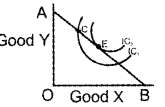
a) Identify:
i) AB
ii) Pont E
b) Elaborate the properties of indifference curve.
c) Point ‘C’ is not the equilibrium of the consumer,
do you agree? Explain.
Answer:
a) i) AB is the Budget line
ii) Point E is the equilibrium point
b) Properties of indifference curves are:
Indifferences curves are negatively sloped.
Indifference curves are convex to origin.
Higher and higher indifference curve represents higher level of satisfaction.
Two indifference curves never intersect each other.
c) I agree. Equilibrium point is reached by satisfying the following conductions.
1) IC must be tangent with budget line.
2) Slope of IC must be equal to slope of budget line.
These two conditions are satisfied at the point E. Hence ‘C’ is not the equilibrium point.
Question 34.
Distinguish between the movement along a demand . curve and the shifts in demand curve. (MAY-2016)
Answer:
Change in quantity demanded due to change in price leads to expansion and contraction of demand. In this case, there is the movement along a demand curve.
Change in quantity demanded due to change in factors other than price leads to increase and decrease in demand. In this case, there is shift in demand curve.
Question 35.
“The consumer’s optimum bundle is located at the point of tangency between the budget line and the highest indifference curve”. Explain the consumers’ equilibrium as per the indifference curve approach with a suitable diagram. (MAY-2016)
Answer:
The interest of the consumer is to purchase those goods and services which provides him maximum satisfaction. So the consumer chooses the best bundle available to him. The consumer always prefers to have bundles on the higher indifference curve. The preference of the consumer to have the bundle, which provides him maximum satisfaction, is known as consumer’s equilibrium. It is the optimum point, a point of maximum satisfaction.
The equilibrium of the consumers is possible only when the budget line is tangent to the indifference curve. The consumer purchases the goods and services on the budget line, which provides him maximum satisfaction. It is possible only when the slope of the budget line ![]() and the slope of the indifference curve (MRS) are equal.
and the slope of the indifference curve (MRS) are equal.

Question 36.
Why there is different price elasticity along a linear demand curve? Illustrate with the help of a diagram. (MARCH-2017)
Answer:
The price elasticity of a linear demand curve is based on slope of demand curve. Slope of the demand curve is the ratio between change in quantity demanded (∆q) to change in price (∆p). So the slope of a demand curve will be different at different points. This can be explained with diagram.

Question 37.
From the Budget line shown below, find the price of good X2 given that the price of X1 good is ? 30. The equation on the Budget line is given as P1X1+ P2 X2=1000 (MARCH-2017)

Answer:

